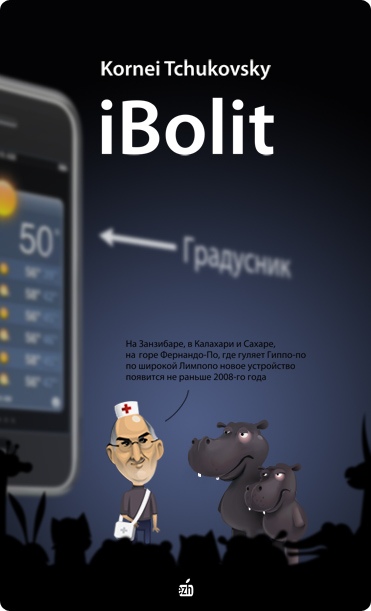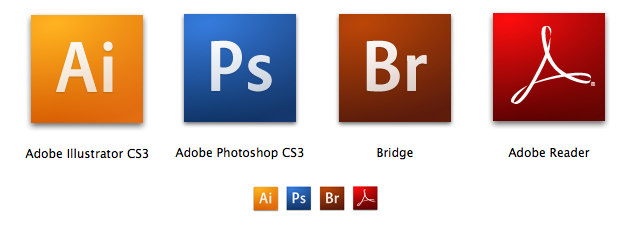Ir iznācis jaunākais, svaigākais saraksts ar Adobe programmu spraudņiem. Tas gan vairāk attiecas tieši uz CS un Acrobat lietotājiem, bet nu skatam cauri. Īpašu uzmanību pievērsiet spraudņiem, kas nāk ar apzīmējumu freelance, jo daudzi no viņiem man ir ļāvuši saīsināt darba stundas līdz darba minūtēm – tomēr tie, kas strādā ikdienā un paši priekš sevis kaut ko taisa, ir daudz tuvāki, nekā tie, kas taisa kaut ko citiem.
Autors: Sergejs Bižāns
-
Apple un Ļebedevs
Divas lietas, par kurām es domāju.
Par pirmo domāju ne tikai es, visi blogi jau ir pied***ti ar ierakstiem par iPhone iznākšanu. Man vislabprātāk, protams, patīk Egora idejas par šo tēmu.

Savukārt otra lieta, par kuru es domāju, ir ArtLebedev. Tam kantorim ir manāms regress iestājies. Nebiju sen neko skatījies, bet tagad apskatot pēdējos darbus esmu vieglā šokā. Kas ir šis vai šis?
Es atvainojos, bet tas ir sū** kaut kāds.
-
Jaunais Adobe grupas produktu paskats
Man jau instalējot Photoshop CS3 Beta šķita, ka tas, ko es redzu, ir tikai programmeru uz ātru roku saveidotais, lai var testēt usability, bet kā izrādās, tad tas tiešām ir jaunais produktu dizains. Vairāk par šo lietu var lasīt šeit: The New Adobe Icons and Branding
Bet man personīgi no komentāriem vislabāk patika šis:
“Just curious…Is Adobe trying to create their own version of a Periodic Table? :-)
L8R,
JD”

-
Acrobat Reader 8
Lūdzu paši, draugi, jūsu sisadmini un visi pārējie – atjauniniet savu Adobe Acrobat Reader versiju šeit, jo tas tiešām ir gana liels un svarīgs atjauninājums kopš Acrobat ģimenes parādīšanās. Viens no būtiskākajiem atjauninājumiem – Acrobat Reader tagad ir ļoti ērts rīks komentēšanai un labošanai dokumentos, ja nav pilnā Acrobat ģimene, pārējie atjauninājumi in general:
Combine multiple files into a PDF package
Combine multiple files into a searchable, sortable PDF package that maintains the individual security settings and digital signatures of each included PDF document.
Auto-recognize form fields
Automatically locate form fields in static PDF documents and convert them to interactive fields that can be filled electronically by anyone using Adobe Reader software*. (Windows® only)
Manage shared reviews
Easily conduct shared reviews — without IT assistance — that allow review participants to see one another’s comments and track the status of the review.
Enable advanced features in Adobe Reader
Enable anyone using free Adobe Reader software* to participate in document reviews, fill and save electronic forms offline†, and digitally sign documents.
Permanently remove sensitive information
Permanently remove metadata, hidden layers, and other concealed information, and use redaction tools to permanently delete sensitive text, illustrations, or other content.
Archive Microsoft Outlook e-mail in PDF
Configure Acrobat 8 Professional to automatically archive e-mail in Microsoft Outlook for easy search and retrieval. (Windows only)
Archive Lotus Notes e-mail
Convert e-mail in Lotus Notes to Adobe PDF to facilitate searching, archiving, and retrieval. (Windows only)
Save in Microsoft Word
Take advantage of improved functionality for saving Adobe PDF files as Microsoft Word documents, retaining the layout, fonts, formatting, and tables.
Enjoy improved performance and support for AutoCAD
More rapidly convert AutoCAD® drawing files into compact, accurate PDF documents, without the need for the native desktop application.
Take advantage of a new, intuitive user interface
Complete tasks more quickly with a streamlined user interface, new customizable toolbars, and a “Getting Started” page to visually direct you to commonly used features.
-
Adobe Photoshop CS3 beta
New features for the Photoshop CS3 beta include the following:
- Non-destructive Smart Filters
Smart Filters are Photoshop filters that are applied non-destructively, and that remain live and re-editable. To apply a Smart Filter, select one or more layers and choose Filter->Convert for Smart Filters. The selected layer(s) will be converted to a Smart Object, to which you can apply filters non-destructively. Smart Filters appear as parameters under the layer to which they have been applied. Edit the Smart Filter mask to adjust the filter’s effects on different areas of the image. Note that any filter is treated as a Smart Filter when you apply it to a Smart Object. - Quick Selection Tool
The new Quick Selection Tool creates selections by painting the general area of interest. Photoshop CS3 analyzes the image to complete the selection automatically. To remove pixels from a selection, hold the Opt (Mac)/Alt (Win) key and paint. You’ll find the Quick Selection tool in the same slot as the Lasso tool in the Tools palette. - Refine Edge
The new Refine Edge feature offers a simple, flexible way to modify the edge of any selection. Available via the Options bar or via the Select menu, the Refine Edge dialog lets you smooth, feather, contract or expand the current selection by using simple slider controls. Experiment with the Radius slider to select irregular or fuzzy edges. - Automatic layer alignment and blending
Using automatic layer alignment and blending, easily combine the best parts of multiple images of the same scene into one “best” image. Simply place multiple, related images on separate layers in one document, and let Photoshop CS3 analyze the contents, moving and rotating the layers so they overlap as precisely as possible. Then use the masking tools to reveal the areas you need from different layers to finalize the elements of the composite image. Automatic layer blending seamlessly blends the color and shading into the final image. The “Auto-Align Layers” and “Auto-Blend Layers” commands are both found in the Edit menu. Note that you must have multiple layers selected simultaneously in the Layers palette before you can apply these commands. - Vanishing Point with multiple, adjustable angle perspective planes
One of the most powerful new features of Photoshop CS2 is now even more flexible. Vanishing Point adjusts brush strokes, healing and cloning as you paint over its perspective planes. In Photoshop CS3, you are no longer restricted to adding planes at 90-degree angles. You can now quickly and easily create multiple planes in any image, connected at any angle. In addition, artwork (for example, a product label pasted from the clipboard) can be wrapped around multiple planes simultaneously. To adjust angles of planes, use the Alt/Option key when dragging on a side point of a plane, or enter a specific angle in the Angle field in the dialog. - Black and White conversion
Advanced black-and-white conversion is now simpler and faster. With the new Black and White adjustment, one button analyzes the image and offers conversion settings. Fine-tune your image with simple sliders that control the conversion of each color. Click and drag any portion of any image to adjust the corresponding tonal range (for example, click and drag on a red car to lighten or darken all red tones). The improved Channel Mixer adjustment includes new black-and-white presets, the ability to save your own settings as presets for reuse later, and the new Total indicator that keeps you informed on the total percentage contribution from all three color channels. - Enhanced Adobe Camera Raw
Camera Raw 4.0 now features Fill Light, Recovery, and Vibrance controls; a parametric tone curve; sophisticated black & white and split toning controls; and more.
- Non-destructive Smart Filters
-
Adobe Creative Suite 2 eSeminar Series for Print Professionals
Šodien pieteicos pasākumam. Vairāk lasiet un piesakieties šeit.
-
Lietas, kas jāiečeko
Pirmkārt jau – tas viss ir galīgi prom no tā, par ko jūs domājat, ka tas ir.
Pirmais: Test your musical skills in 6 minutes. Man ļoti pavirši to visu darot, fonā skanot radio SWH sanāca 75.0% Correct.
Otrais: Sitemaps. Esot Google ar Yahoo kopā taisījuši. Noteikti vēlāk pastudēšu.
Nu un pēdējais: WebEditors salīdzinājums. Vienkārši tāpēc, ka man šis jautājums šobrīd ir aktuāls.
-
Jill Bell’s Simple Design Tips
1. Organize your material into levels of importance. Make sure the information is logical, clear and assessable.
2. Edit. Eliminate everything that is fluff. Make sure you have the journalistic essentials of five W’s and one H: who, what, where, when, why and how (if appropriate).
3. Choose your typefaces. Decide what typefaces reflect the subject matter the best. Consider who your reader/audience is. Decide what will be used as headlines, sub-heads, and the body copy. Check to see if there are any special characters you need in your font.
4. It’s much easier to mix a serif font and a sans serif font than it is to mix two serif fonts or two sans serif fonts. Simplest method for a good, cohesive look: choose an extended font family with italics and different weights and stay with it.
5. Serif fonts are generally better for text, sans serif for headings and titles. Serif fonts tend to be more readable, sans serif more legible (why they are also used more in signs).
6. Keep line length short for improved readability. Flush left makes the type look and read better if the design allows. 10-12 point type is generally the easiest, quickest read.
7. Don’t use all caps for text. It’s just not very readable and you’ll loose your audience.
8. Use pictures or graphics. The adages say it all: “A picture is worth a thousand words” and “variety is the spice of life”.
9. Less is more. Don’t get carried away and try to put everything in. One picture may be better than five. White space is good and adds clarity and sophistication.
10. For print: your text and logo will probably look better smaller than you think it should be.
11. For online: your text will probably look better bigger than you think it should be. Separate out long pages of text onto their own page or create a PDF: your average internet surfer doesn’t want to wade through a lot of text, and those who do want to read articles want to be able to print the text out with one printing command.
12. Jill’s surefire rule of 3: Limit yourself to three colors (background counts as one), three typefaces (two should be in the same font family), and three sizes of type. One color, typeface and size of type should occupy 2/3 of the piece, the second element 2/3 of the remaining third, and the remaining 1/9th should be the accent color, the headline type and size (or footnote size and type).
13. Jill’s primary colors: black, white and red.
14. Proofread. Proofread again. Have someone else proofread it. Proofread it again.
15. Break all the rules.
Oriģināls rodams šeit: Jill Bell’s Simple Design Tips. Turpat var atrast arī daudz ko citu interesantu, kas var noderēt burtu mācību apgūstošajiem un arī tiem, kas burtus saprot kā mākslas veidu. Un vispār jau tas ir Typo-L is: a mailing list dedicated to the discussion of type, typography, typeface design, and type history.




